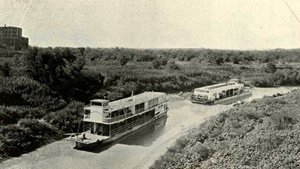By Frances James (1922 – 2019)
The city had expanded the limits in 1890 and Ross Avenue, first named Carondelet, was one of the more choice places to live in Dallas. It was one of the first streets in Dallas that was paved, which was a new process. Macadam paving was first used in 1885 and Ross Avenue between Ervay and the H&TC tracks had been completed. Ross was re-named for two brothers who had immigrated to Texas in 1854. William settled in Smith County where he planted an orchard and a vineyard. His wines became known for their delicacy and purity. Andrew J. Ross served in the Civil War and came to Dallas in 1866 to join his brother who had moved to Dallas by this time. They both became involved in the Real Estate Business in Dallas.
William H. Gaston had purchased ten acres of land in the Grigsby League for $100.00 an acre soon after arriving in Dallas in 1868. Gaston built his own first house on the southwest corner of Ross and Pearl. By 1888, he had built a much larger home on White Rock Road (Swiss Ave.) and sold the Ross Avenue site to Alfred Horatio Belo.
Colonel Alfred Horatio Belo came to Dallas from Galveston in 1885 and had the small frame house on the property removed and constructed the beautiful Georgian Colonial designed by Herbert Greene that is still standing. Belo acquired the Galveston News and later the Dallas Morning News. After Belo died in April 1901 the family stayed in the home a few more years. Alfred Jr. died in 1907 and eventually this facility was leased to the Loudermilk/Sparkman Funeral Home. Currently the Belo mansion is the home of the Dallas Bar Association.
Gaston also sold three-quarter acres of vacant property on the northeast corner of Ross and Pearl to L.M. and Eliza F. Martin in 1885. By 1887 the Martins sold to S.M. and Bobbie McDaniel Welch. In 1890 the Welchs sold to Bishop Gallagher in Galveston. Bishop Gallagher transferred the title to Bishop E.J. Dunne on October 1, 1895. There were other sites conveyed at this same time. The land that had been purchased at the northeast corner of Ross and Pearl was for the Sacred Heart Cathedral.
Many mansions around the turn of the century were being built on Ross Ave. Some of the more prominent men in Dallas history lived on this paved street. Jules Schneider’s home was built in 1879 on the corner of Ross and Ervay. James Flanders, one of Dallas’ first architects had designed his High Victorian Italianate mansion. Schneider was president of a wholesale grocery store and the Consolidated Street Railway Company.
Across Ross Avenue from the Cathedral property, was the home of John S. Armstrong, president of Armstrong Packing Company and the founder of Highland Park. His Queen Anne mansion was completed in 1891 but like so many other beautiful structures was torn down in 1927.
Another massive home was that of John C. Conway, on the corner of Ross and Harwood. Built in 1902, it became the Dallas Academy of Music and School of Opera, before it was destroyed in 1930 for a tire store.
Of all the mansions that had been built during this time period is the one built for the Charles H. Alexander family on Ross at Annex. Alexander was a wealthy banker, manufacturer, and entrepreneur and was willing to spend $125,000 in 1906.
This house was purchased in 1930 by the Dallas Women’s Forum.
Ross Avenue was also the choice of several magnificent churches. The corner of Ross and Harwood was chosen in the 1920s, after several other locations had been considered, for the First Methodist Church. This corner had been the site of the Miranda Morrill home that was demolished in the 1920s.
The Ross Avenue Baptist Church was built in 1915 near the easternmost end of Ross, that at one time was the longest street in Dallas. This site had been a portion of the dairy operated by Anna and Christian Moser. After Christian died, Anna divided some the land into the Moser Addition and arranged for the corner land to be used by the church.
Episcopal Bishop Alexander C. Garrett who came to Dallas in 1874 had acquired twenty acres of land at the far end of Ross Avenue to establish St. Mary’s Institute in 1889 for the education of girls and young women. The Chapel built for this school is now St. Matthews Cathedral for the Episcopal Diocese of Dallas.


